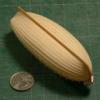-
Posts
13,313 -
Joined
-
Last visited
Content Type
Profiles
Forums
Gallery
Events
Everything posted by druxey
-
Good question. Yes, the rule is that if any plank is cut into by more than half its width, then the neighbouring plank is widened instead. This is to address a strength issue.
-

HMCSS Victoria 1855 by BANYAN - 1:72
druxey replied to BANYAN's topic in - Build logs for subjects built 1851 - 1900
Yes, I was wondering about the metal rimmed (solid metal?) trucks on the carriages as well. The model is looking great as the details bring it to life.- 1,006 replies
-
- gun dispatch vessel
- victoria
-
(and 2 more)
Tagged with:
-
Always nice to see an unusual subject modeled!
- 81 replies
-
- egyptian
- byblos ship
-
(and 1 more)
Tagged with:
-
I meant if you had a ZAZ number for the plan, Mark! Sorry if I was unclear. I always thought that the outer plank thickness at the stern was concealed behind ( i.e. forward of) the dummy light and munion. Also, unless the captain was extremely obese, the seat would be quite wide enough to comfortably ensconce himself in a seaway!
-

Lapwing 1816 Revenue Cutter
druxey replied to iMustBeCrazy's topic in CAD and 3D Modelling/Drafting Plans with Software
Those counter timbers look a little thick in siding to my eye. Also as per the illustration posted above, usually the counter timbers slope slightly inward. -
That was a small fortune back then!
-
Quite an achievement, Keith: 96 holes, no drill breakage and no evidence of the drill bit wandering either! Well done.
-
Lovely! And those belaying pins look so much better now.
- 87 replies
-
- royal caroline
- yacht
-
(and 1 more)
Tagged with:
-
I've seen contemporary models with both open and solid balcony rails, Mark. Polyphemus, 64 of 1781 definitely showed a closed rail on the 'as built' draught. Take your pick! The serpentine rails are more graceful though, I think. When it comes to projection drawing, it's much easier to correct one aspect at a time. Trying to juggle and correct for round aft, aft slope etc. at the same time leads to nervous breakdowns!
-

Hawse holes
druxey replied to allanyed's topic in Building, Framing, Planking and plating a ships hull and deck
My understanding is that they were usually parallel to the keel and angled upward and in at about 10 degrees or so. This would apply to hawse pieces that are erected parallel to the keel, the usual arrangement. In the photo above, the model's hawse pieces on both sides (which are framed differently) are canted, which would explain the holes running at the same angles as the hawse pieces. -
Your display of her side through time is very impressive. Congratulations on a very fine job of research as well as painting. The rigged fore chains with stowed anchor presentation looks intriguing. The Augsburg show would have been fun to attend!
-
Posting? Yup. Sense of humor intact? Yup. You must be improving!
- 2,696 replies
-
- heller
- soleil royal
-
(and 9 more)
Tagged with:
-
A good improvement visually, Maury. About beeswax: from my reading, it's a bit of an old wives' tale that has been passed down generations of ship modelers. It is acidic in pH, so eventually.... If you must wax, use Renaissance wax, which is pH neutral.
-
Glad to read that you are improving, Marc. Take it easy while you recover. We can wait for you!
- 2,696 replies
-
- heller
- soleil royal
-
(and 9 more)
Tagged with:
-
On the question of dummy lights (blank windows): The outer lights of the stern galleries were usually blank. The reason for this was that just forward of these dummies in the quarter galleries were the 'seats of office', or heads.
- 1,784 replies
-
- winchelsea
- Syren Ship Model Company
-
(and 1 more)
Tagged with:
About us
Modelshipworld - Advancing Ship Modeling through Research
SSL Secured
Your security is important for us so this Website is SSL-Secured
NRG Mailing Address
Nautical Research Guild
237 South Lincoln Street
Westmont IL, 60559-1917
Model Ship World ® and the MSW logo are Registered Trademarks, and belong to the Nautical Research Guild (United States Patent and Trademark Office: No. 6,929,264 & No. 6,929,274, registered Dec. 20, 2022)
Helpful Links
About the NRG
If you enjoy building ship models that are historically accurate as well as beautiful, then The Nautical Research Guild (NRG) is just right for you.
The Guild is a non-profit educational organization whose mission is to “Advance Ship Modeling Through Research”. We provide support to our members in their efforts to raise the quality of their model ships.
The Nautical Research Guild has published our world-renowned quarterly magazine, The Nautical Research Journal, since 1955. The pages of the Journal are full of articles by accomplished ship modelers who show you how they create those exquisite details on their models, and by maritime historians who show you the correct details to build. The Journal is available in both print and digital editions. Go to the NRG web site (www.thenrg.org) to download a complimentary digital copy of the Journal. The NRG also publishes plan sets, books and compilations of back issues of the Journal and the former Ships in Scale and Model Ship Builder magazines.


